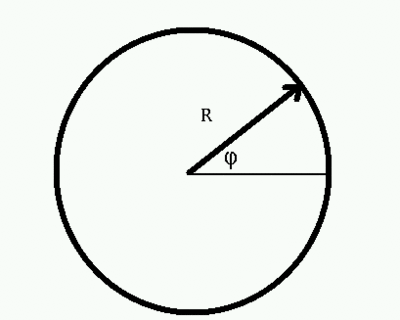
In the previous two lectures we have looked at some simple potential-density pairs which can be used to model the mass distribution and the stellar orbits in galaxies.
In this lecture we will look at stellar orbits, and how they can be determined from the Gravitational potential.
The lecture is based closely on Binney and Tremaine's chapter 3, "The orbits of stars". We begin with the simplest case, that of a spherically symmetric, stationary potential (i.e. not changing with time).
Such potentials describe the gravitational field of a centrally directed field of force in which the force any any particle is always directed towards the same, central point.
The position of a star is denoted by the radial vector r,
r = r er.
The force acting on the star is F(r)
F(r) = F(r) er.
The velocity of the star is the time rate of change of the position
v(r) = dr/dt
and the equation of motion of the star describes the rate at which the velocity changes:
dv/dt = d2r/dt2 = F(r) er.
Now consider the time derivative of the quantity r x dr/dt.
We have
d(r x dr/dt) = dr/dt x dr/dt + r x d2r/dt2 = F(r)r x er = 0because the cross product of a vector with its own unit vector is zero.
The quantity r x dr/dt, called the angular momentum, L, does not change with time and is thus a constant of the motion,
L = r x dr/dt = constant.
The vector L lies perpendicular to the plane of the position and velocity vectors r and v. Since L is constant, the star must move in a single plane (called the orbital plane).
We can now simplify matters considerably since we know the star moves in a plane. If we introduce the planar polar coordinates (r, φ).

In this coordinate system the equations of motion become
d2r/dt2 − r (dφ/dt)2 = F(r) (1)
and
2 (dr/dt) (d&phi/dt) + r d2&phi/dt2 = 0 (2)
Conservation of Angular Momentum
The second equation, when multiplied by r and integrated, leads to
r2 dφ/dt = const = L (3)
i.e. we can recover the constancy of the angular momentum.
Force field from the orbitEquations (1) and (2) allow us to derive the useful relations d2r/dt2 − L2/r3 = F(r) d2r/dφ2 − (2/r)(dr/dφ)2 − r = r4 F(r)/L2. It turns out that a very useful substitution to make is u = 1/r. In this case eqns (1) and (2) can be used to show that d2u/dφ2 + u = −F(1/u)/L2u2 (4) These equations are useful in recovering the form of the force field if the form of the orbit is known. |
A central force field is a conservative field, and we can define the potential Φ(r), as
dΦ(r)/dr = − F(r).
The potential can be found to within an arbitrary additive constant by integrating this equation. The constant can be obtained by setting, for example,
Φ(r) = 0 at r = 0 or
Φ(r) = 0 at r = ∞.
The kinetic energy is given by KE = (mv2)/2. In polar coordinates this becomes
KE = m( (dr/dt)2 + r 2(dφ/dt)2 ) / 2.
The total energy E is
E = KE + Φ.
Using the conservation of angular momentum (3) above and the definition of KE, one can show that
E = (mL2/2r4) [ (dr/dφ)2 + r2 ] + Φ(r). (5)
Again using the substitution u = 1/r, we can gain considerable insight into the type of orbits permitted because the energy equation (5) takes the form:
2E/L2 = 2Φ/L2 + u2 + (du/dφ)2.
If we now define bound orbits as those for which the radius r is always finite, while for unbound orbits the radius r tends to infinity. Thus, for bound orbits u = 1/r is always finite while for unbound orbits u tends to zero.
In a bound orbit, we will have the condition that at certain times du/dφ = 0, so that
u2 + 2[ Φ(1/u) − E]/L2 = 0.
This equation has two roots, u1 and u2.
A "bound" star or planet orbiting in a conservative potential will thus move in its orbit between two radii r1 = 1/u1 and r2 = 1/u2.
The inner of these two radii is called the pericenter and the outer is called the apocenter. In the solar system, a planet's inner and outer radii are called perihelion and apohelion; the equivalent terms for a star in the Galactic potential are perigalacticon and apogalacticon. Some examples are shown in the next two figures.
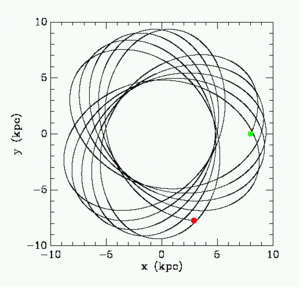 |
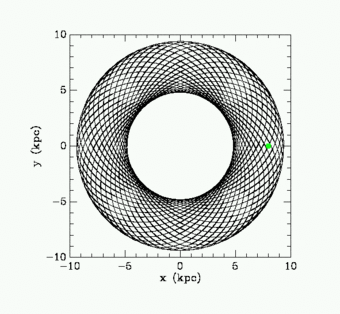 |
| Left panel: the orbit of a star in the potential of the Milky Way presented in the previous lecture. The star's initial position is shown by the green dot, and the final position by the red dot. The initial velocity of the star was (U,V,W) = (-90,180,0) km/s. Note that the star begins by moving outward in X, as expected since its U velocity (i.e. dX/dt) is negative. The orbit forms a "rosette", and oscillates between a maximum radius or apogalacticon and a minimum radius or perigalacticon. The orbit was calculated over 2 Gyr, or about 20 percent of the lifetime of the Galaxy. Right panel: over a much longer time, 20 Gyr, (i.e. longer than the present age of the Galaxy), the right hand figure shows the peri- and apogalacticon are now very clear for this orbit. |
In the discussion of central forces so far we have not yet specified the form of the force. The results above there for apply to all "central forces", whose strength depend only on the radius r.
We now consider some examples of different central forces.
Let the potential be of the form
&Phi(r) = &Omega2r2/2 + const
this is the same form as the potential inside a sphere of uniform density, as we saw in lecture 3.
Since the force is "central" one, we know that motion is confined to a plane, and so can define Cartesian coordinates in this plane as
x = r cos φ
y = r sin φ.
Using dΦ(r)/dr = − F(r) we have
F(r) = −Ω2r = d2r/dt2.
Hence the equations of motion are simply
d2x/dt2 = −Ω2x
and
d2y/dt2 = −Ω2y.
These equations are well known as describing a simple harmonic oscillator and have solutions as functions of time:
x = Axcos(Ωt + ψx) and
y = Aycos(Ωt + ψy).
where Ax, Ay, ψx, and ψy are constants of the motion, the A's being the amplitude of oscillation and the ψ's being the initial phase angles of the orbit.
The period of the motion P is given by P = 1/Ω in both x and y, so the
orbit has the property of being closed (i.e. the star returns to its
starting point after 1 period of oscillation). The orbits are
ellipses centered on the center of attraction.
The planets moving in the potential field of the Sun travel on orbits first described by Kepler. To a close approximation, the potential is that of a point mass
Φ(r) = −GM/r
and the force acting at r is
F(r) = −GM/r2
and if we now use eqn (4) above, i.e.
d2u/dφ2 + u = −F(1/u)/L2u2
with u = 1/r, then
d2u/dφ2 + u = GM/L2.
We have a 2nd order differential equation in u and φ, for which there is a general solution
u(φ) = C cos(φ − φ0) + GM/L2 (6)
where C and φ0 are constants.
We now make two definitions :
e = CL2/GM
and
a = L2/GM(1-e2)
these two quantities are called the eccentricity and the semi-major axis of the ellipical orbit.
Using these definitions we can now re-write the solution to Eqn (6) as
a (1-e2)
r(φ) =
--------------------.
1 + e cos(φ − φ0)
This has lead us to orbits of the following types:
| eccentricity | orbital type |
| e > 1 | Hyperbola |
| e = 1 | Parabola |
| e < 1 | Ellipse |
The two first types, the hyperbola and the parabola are unbound. For e < 1, the radius r is always finite, and is a periodic function of φ i.e. it is bound. Such a star will oscillate between the pericenter and apocenter, whose values are found by setting cos(φ − φ0) = −1 and 1:
rapo = a(1-e2)/(1-e) = a(1+e)
rperi = a(1-e2)/(1+e) = a(1-e).
Here are some different solutions to the equation:
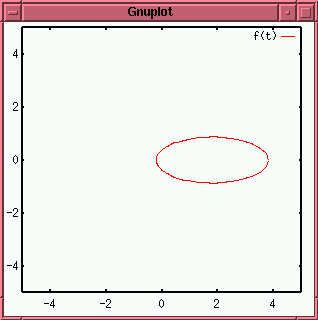
a = 2, t0 = π , e = 0.9 | 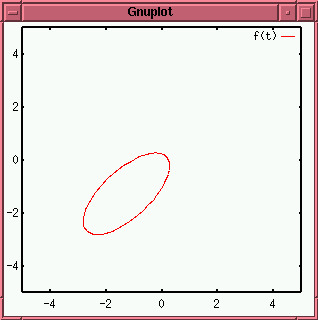
a = 2, t0 = π/4, e = 0.9 |
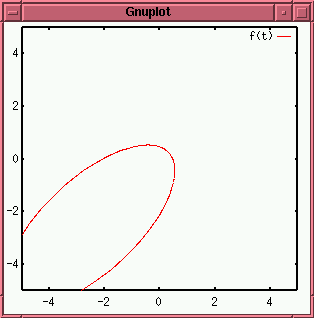
a = 4, t0 = π/4, e = 0.9 |
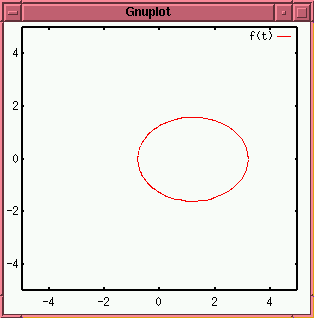
a = 2, t0 = π, e = 0.6 |
Plotting closed curves like this requires a special technique in GNUPLOT -- one has to define the x and y coordinates of the curve parametrically. An example in gnuplot will help make this clear; the parametric variable in the example is t:
set parametric
a = 2.0
e = 0.6
t0 = pi/4.0
f(t) = a*(1-e**2)/(1+e*cos(t-t0))
plot [0:2*pi] [-5:5] [-5:5] f(t)*sin(t),f(t)*cos(t)
| Exercise #1: use gnuplot to plot the orbits of the stars in the figure above. Choose appropriate values of a and e which show examples of an hyperbolic and a parabolic orbit. |